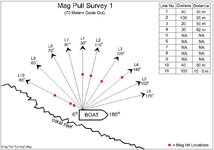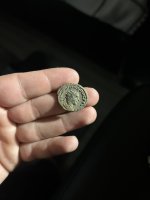deepsix47
Hero Member
- Jul 26, 2006
- 644
- 17
- Detector(s) used
- Fisher Impulse, Fisher CZ-21, Minelab X-Terra 70
- Primary Interest:
- All Treasure Hunting
An inherent risk of Magging shallow water, especially reefs, is snagging and losing the fish. Not only does this get very expensive, it also can cost a great deal of time in locating and recovering the unit. I was just wondering if anyone had come up with a solution for this issue. The most common thoughts such as tubes, surf boards, etc. have all been tried and are sadly lacking in their effency as they either do not work in heavy sea conditions, at varying speeds or do not want to tow true behind the boat.
I had an idea when we were working the 1715 fleet and Aquanut and I were able to mag any water that we could run the boat in at any speed (I'm not going to share it here yet as we kept it pretty quite and I haven't talked to him yet) but will if he agrees.
Anyway, who else has solved this problem? Actually, once set up, it works anywhere, under any sea conditions and in deep or shallow water.
Deepsix
I had an idea when we were working the 1715 fleet and Aquanut and I were able to mag any water that we could run the boat in at any speed (I'm not going to share it here yet as we kept it pretty quite and I haven't talked to him yet) but will if he agrees.
Anyway, who else has solved this problem? Actually, once set up, it works anywhere, under any sea conditions and in deep or shallow water.
Deepsix








